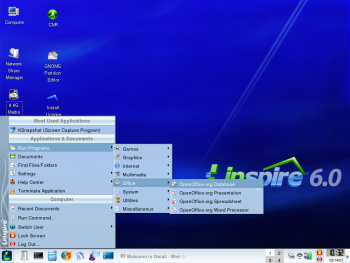Author: Mayank Sharma
Former Linspire CEO Kevin Carmony was pretty gung-ho about the company’s upcoming release back in June. He said it would “fill some key holes in our current offering.” Unfortunately Linspire 6, released last week, lacks the refinements you’d expect in a distro you pay $50 to download. It drops some key distinguishing features, and in return gains only some Microsoft technology as spelled out in the Microsoft patent covenants Linspire agreed to. This release seems to be about deferring to Microsoft.
The Linspire 6 CD, like its predecessors, is both an install disc and a live CD. Linspire 6 has impressive hardware support; running on both my dual core desktops (E4400 and E6300) and slower 1.3GHz Celeron laptop, it detected everything from the PCMCIA and PCI wireless cards to USB pen drives, USB hard disks, and USB camera.
Linspire 6 installs quickly — less than 10 minutes on the dual core boxes — after the simplest of installation procedures. While the installation offers an advanced installation option, all you can do with it is select the partition you want to install on. If you like keeping your /home, /root, and other directories on separate partitions, you’re out of luck. Linspire is one of the few distributions that still defaults to a ReiserFS filesystem, though you get the option to format the partition and install it on other filesystems, such as ext3.
It’s after installation that Linspire 6 shows it rough edges. Linspire’s previous major release, Linspire 5.0, was a showstopper of a distro. It turned eyes with its user interface eye candy and impressed with its applications. Linspire 6 disappoints in both of those areas. The release has a standard wallpaper, no 3-D desktop, and has dropped some of its own custom applications, such as LTorrent (now replaced with KTorrent) and Nvu.
For a $50 distro on a CD, Linspire doesn’t pack much. You get a standard set of office and Internet apps, including the OpenOffice.org office suite, Pidgin for instant messaging, RealPlayer for playing music, K3b for burning CDs and DVDs, KTorrent for downloading torrents, and other KDE apps, including KMPlayer and KDE games. You configure the system using KDE’s Control Center. Also included is Firestarter for setting up firewalls and GParted for managing partitions. Like many distros, Linspire has custom apps as well, but only two — Lsongs and Lphoto. The distro uses a modified version of Firefox for Web browsing and includes Linspire’s popular Hot Words extension.
One of the best user-oriented feature of Linspire 5.0 was the guided video tour and help. This has been dropped from Linspire 6.0. In fact there isn’t any Linspire-specific help bundled with the release. It comes with the standard KDE help and nothing more.
To make matters worse, this latest release has some very irritating habits. For example, when you click the terminal quick launch icon in the taskbar at the bottom, instead of popping up a terminal window, it brings up a menu with options to launch a shell, a Linux console, a Python interpreter, or a root terminal. This might be useful to a power user but is irritating for Linspire’s primary audience of desktop and office users.
But let’s not forget the list of software highlighted in the press release — Microsoft’s TrueType fonts, the ability to play Windows Media files, and the ability to open and save documents in Microsoft’s OpenXML format. Yes, these are all included and work without a glitch. But this doesn’t make Linspire a more interoperable distro. It failed to mount all FAT32 and NTFS Windows partitions on my computers.
The other bleeding edge software in this release is the beta version of the Linspire-developed Click-N-Run (CNR) service now available to other distros as well. The first time you run it, Linspire syncronizes your local installed software repository with the one on the CNR Web site, which it then opens in the Web browser. CNR stands up to its name — I used it to install several apps, including Beryl and Trigger, a 3-D rally game, without a hitch.
It was only when I wanted to remove these apps that I realized that Linspire includes no package management utility. You can grab the KDE package manager from CNR, or, since Linspire 6 is based on Ubuntu, use apt-get to download Synaptic.
In another installation-related issue, I couldn’t get the kernel sources for the running Linspire 6 kernel (2.6.20-16-lowlatency) to install vmware-tools while running the distro under VMware 6. The one available on CNR said it wasn’t for the running distro, and Synaptic didn’t have this kernel at all.
Linspire is one of the few non-free distros available. As a single-CD distro, Linspire has a huge uphill battle against commercial DVD distros. Linspire 6.0 won’t win many converts, except perhaps for companies frightened by the recent patent infringnment claims against Linux vendors whose priority is a distro that offers Microsoft’s patent promises.
Categories:
- Linspire/Freespire
- Reviews
- Distributions





